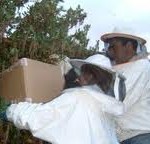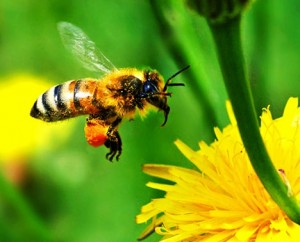 One way of acquiring bees whether to replace winter losses, strengthen weak colonies or start new ones, is to collect a swarm. Primary swarms are valuable especially in late Spring as they may contain as many as 25,000 bees plus the queen. In comparison, a purchased 3-pound package will contain only about 10,500 bees. However a swarm is not usually recommended as a way for new beekeepers to get started, for several reasons. The main problem with a swarm especially for a new beekeeper is that there is no way of knowing if the bees are carrying diseases or what temperament the bees are going to have.
One way of acquiring bees whether to replace winter losses, strengthen weak colonies or start new ones, is to collect a swarm. Primary swarms are valuable especially in late Spring as they may contain as many as 25,000 bees plus the queen. In comparison, a purchased 3-pound package will contain only about 10,500 bees. However a swarm is not usually recommended as a way for new beekeepers to get started, for several reasons. The main problem with a swarm especially for a new beekeeper is that there is no way of knowing if the bees are carrying diseases or what temperament the bees are going to have.
Going out and collecting a swarm also requires some experience of bee behavior and handling. There are three main things to consider about a swarm, these are: how long has the swarm been there, where is the swarm located, e.g is it high up in a tree and the size of the swarm. Swarms normally cluster on a tree limb, shrub, fence post, lamp post or on the side of a building. You will need to consider health and safety issues before proceeding to remove a swarm.
Try always to remove the swarm gently, disturbing the cluster as little as possible and put it directly into a hive or enclosed container (a cardboard box with a tight-fitting lid is a good solution) to transport it to a new hive or location. If the swarm cannot be cut down, either shake or scrape the bees into a lightweight box, remember the swarm can be heavy, so the box needs to be quite robust.
When a swarm settles in a very high tree or on any other inaccessible structure, it is best to leave it there. Such swarms may be an after-swarm with one or more virgin queens and their successful capture can be very difficult. Sometimes you can knock these high swarms into a bucket at the end of a long pole and then lower it to a collecting box, but this is not for the faint hearted.
Once you have successfully captured a swarm, you can introduce the swarm into your own equipment by either shaking or dumping the bees into an open hive with several frames removed or simply by shaking it in front of the hive. If you were successful in getting the queen with the rest of the swarm once she is inside the bees will adopt the hive. Using drawn combs is better than foundation when introducing swarms to an empty hive, but one or two drawn combs, preferably with pollen, brood and/or honey (from a disease-free colony), combined with foundation also works.
Some new beekeepers set up their hives and hope a passing swarm moves in; you would have to be really lucky for this to happen. However it is possible instead of waiting for swarms to simply appear to try to bait a swarm. Pheromone lures (available from beekeeping supply stores) placed in special light-weight bait hives or empty hive bodies (with or without drawn comb) can be used to lure swarms, with some success. This is probably however not a good idea if you are looking to start beekeeping and get your first colonies going, but is worth a try down the line, as one way of trying to cheaply expand your operation.
More about Acquiring and Installing Bees

